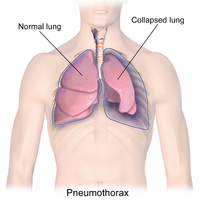
Photo from wikipedia
CASE A 39-year-old man presented to his primary care clinician after being evaluated at an urgent care facility on two separate occasions. History At the initial urgent care visit 3… Click to show full abstract
CASE A 39-year-old man presented to his primary care clinician after being evaluated at an urgent care facility on two separate occasions. History At the initial urgent care visit 3 weeks ago, he was prescribed inhaled budesonide/formoterol for presumed asthma. On his second visit a week later, he was given levocetirizine for what was presumed to be allergic rhinitis. He obtained no relief from either medication. At both urgent care visits, he complained of a productive cough with yellow sputum and an associated nonradiating retrosternal chest pain that he described as feeling like a muscle ache. The cough and chest pain were intermittent but progressing in frequency and intensity. He initially rated the pain as a 5 on a 0-to-10 pain intensity rating scale and said it had started 6 weeks earlier. At the current primary care visit, he rated the pain as an 8. The patient did not seek care from his primary care provider until he developed generalized myalgias and a frontal, pressure-like headache that he rated as a 5. These symptoms started about 24 hours earlier. Over the past 24 hours, he reported a maximum oral temperature of 102° F (38.9° C). He self-treated with ibuprofen for the chest pain and fever, which gave him temporary relief of both symptoms; his last dose was 12 hours ago. He denied any similar episodes in the past. He also denied night sweats, weight loss, fatigue, rashes, pleuritic chest pain, dyspnea on exertion, hemoptysis, palpitations, edema, abdominal pain, abdominal fullness, bloating, back pain, recent international travel, and ever using tobacco. Spirometry results from the urgent care visits were consistent with moderate obstruction, but a chest radiograph had not been ordered by the urgent care center. The patient’s medical history included hypertension and surgery 6 years ago for carpal tunnel syndrome in his right wrist. He was generally healthy with the exception of infl uenza A the last two fl u seasons. He worked as a plumber and denied exposure to any environmental toxins. His family history was noncontributory. Physical examination The patient’s vital signs were BP, 110/80 mm Hg; pulse, 80 and regular; respirations, 14 and unlabored; oral temperature, 96.8° F (36° C); Spo2, 93% at rest on room air. He was 5 ft 7 in (170.2 cm) tall, weighed 189 lb (85.7 kg), appeared well developed and well nourished, and was in no acute distress. Signifi cant fi ndings included left lower lobe wheezes heard on auscultation along with palpable nontender mild bilateral cervical adenopathy. The abdominal examination was negative for distension and hepatosplenomegaly and the remainder of the physical examination was unremarkable. Diagnostic testing A rapid infl uenza test was negative for both infl uenza A and B. A complete blood cell (CBC) count and basic metabolic panel were both normal with the exception of a white blood cell count was at the upper limit of normal at 10,500 cells/mm3 (normal range, 3,60011,000 cells/mm3). Spirometry revealed moderate obstruction with an FEV1 of 57%. A chest radiograph revealed extensive widening of the mediastinum suspicious for mediastinal adenopathy (Figure 1) and a left lower lobe infi ltrate. A chest CT was recommended to further evaluate the widened mediastinum. The CT scan was consistent with a left-sided 6.7x7.2x5.6 cm anterior mediastinal mass (Figure 2). Also noted on the CT scan was extensive Amy Roberts is academic coordinator and an assistant professor in the PA program at Hofstra University in Hempstead, N.Y. Denise Rizzolo is an assistant clinical professor of the Pace Completion Program in the Department of Physician Assistant Studies in New York City and an associate professor in the School of Nursing at Kean University in Union, N.J. The authors have disclosed no potential confl icts of interest, fi nancial or otherwise.
Journal Title: JAAPA : official journal of the American Academy of Physician Assistants
Year Published: 2018
Link to full text (if available)
Share on Social Media: Sign Up to like & get
recommendations!